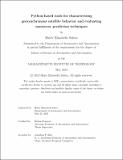| dc.contributor.advisor | Linares, Richard | |
| dc.contributor.author | Solera, Haley Elizabeth | |
| dc.date.accessioned | 2023-07-31T19:25:57Z | |
| dc.date.available | 2023-07-31T19:25:57Z | |
| dc.date.issued | 2023-06 | |
| dc.date.submitted | 2023-06-16T11:32:04.681Z | |
| dc.identifier.uri | https://hdl.handle.net/1721.1/151249 | |
| dc.description.abstract | Geosynchronous (GEO) satellites maneuver frequently to maintain their Earth-relative position despite drift incurred from natural perturbations, but quantifying their diverse maneuver patterns can be challenging. Even for individual satellites, between one station-keeping cycle and the next, the frequency, magnitude, and direction of maneuvers can change. Additionally, there is very little accountability among operators to disclose detailed mission objectives and precise orbital data or to adhere to operational guidelines. This complicates the process of characterizing station-keeping control objectives, predicting maneuvers, and recognizing the early signs of a shift in a satellite's pattern of life (PoL). Characterizing PoLs for a diverse range of GEO satellites can help to contextualize historic on-orbit behaviors and behavior patterns, cultivate generalized maneuver prediction on a large scale, and help future behaviors to be quickly identified as anomalous, nominal, or indicative of a certain mission objective. This work presents two Python tools designed to address these challenges by improving the general accessibility of broad-scale PoL characterization and predictive aspects of Space Situational Awareness (SSA).
First, a nomenclature for a generalizable PoL model is proposed, and a simple algorithm is introduced to enable PoL characterization according to this model. The algorithm is shown to efficiently process a large number of satellite histories by isolating PoL shifts - called nodes - even from sparse or low-precision position histories like collections of two-line-element (TLE) sets. Then, a second simulation tool is described and demonstrated to evaluate probabilistic maneuver prediction models in context of physical viewing constraints determined by user-defined surveillance scenarios. This work explores the potential of both tools to address data accessibility challenges and facilitate GEO satellite behavior characterization in order to foster a more cohesive and communicative SSA research community. | |
| dc.publisher | Massachusetts Institute of Technology | |
| dc.rights | In Copyright - Educational Use Permitted | |
| dc.rights | Copyright retained by author(s) | |
| dc.rights.uri | https://rightsstatements.org/page/InC-EDU/1.0/ | |
| dc.title | Python-based tools for characterizing geosynchronous satellite behavior and evaluating maneuver prediction techniques | |
| dc.type | Thesis | |
| dc.description.degree | S.M. | |
| dc.contributor.department | Massachusetts Institute of Technology. Department of Aeronautics and Astronautics | |
| mit.thesis.degree | Master | |
| thesis.degree.name | Master of Science in Aeronautics and Astronautics | |
